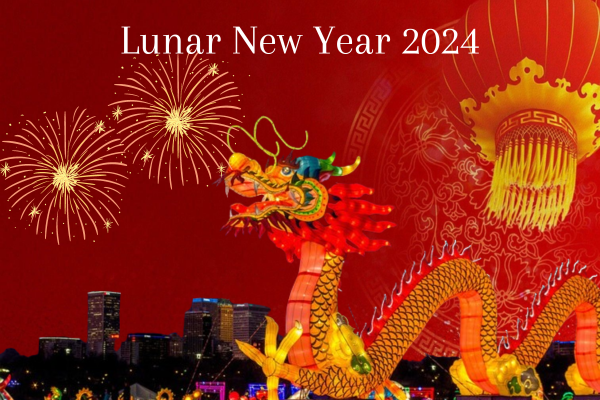
Lunar New Year 2024 article explores the colorful cultural mosaic that is the core of the Lunar New Year celebrations for Asian Americans.
Asian American groups around the country are getting ready for festive ceremonies to bring in the Lunar New Year as the Year of the Dragon approaches. Beyond national boundaries, diaspora communities worldwide enthusiastically celebrate this cultural extravaganza, which has been observed in many Asian countries.
This coming Lunar New Year, known as the Spring Festival in China, Tet in Vietnam, and Seollal in Korea, promises a rich tapestry of parades, family get-togethers, community carnivals, traditional food treats, and spectacular fireworks. We explore the various customs, beliefs, and the unique meaning associated with the Year of the Dragon as we dive into the rich variety of Lunar New Year celebrations in the spirit of this auspicious event.
The Lunar New Year and Zodiac Animals
The Lunar New Year begins with the first new moon of the lunar calendar, lasting 15 days until the first full moon. Each year is associated with an animal from the Chinese zodiac, with 2024 being the Year of the Dragon. While China follows the traditional zodiac, other Asian countries may have variations. For instance, the Vietnamese zodiac includes the cat and buffalo instead of the rabbit and ox.
The Chinese zodiac consists of twelve signs, which are as follows: Rooster, Dog, Pig, Horse, Goat, Monkey, Ox, Tiger, Rabbit, Dragon, Snake, and Horse. Every sign has an animal name, and every animal has distinct qualities of its own.
Lunar New Year Beliefs and Traditions
The colorful tapestry of Lunar New Year customs is largely shaped by old tales. One such story revolves around Nian, a terrifying creature that used to terrorize New Year’s Day celebrations. Communities created a wide range of practices to ward off evil and bring in a prosperous year in order to combat this bad energy.
In this age-old battle against negativity, using the color red becomes an effective strategy. The go-to weapons become eye-catching lanterns, brilliant red decorations, and the deafening sound of firecrackers. This group effort is a symbolic act of removing bad luck from homes and lives rather than just a show of celebration.
The theme of the festival is extending an invitation to wealth and welcoming good fortune. The color red, which is selected for these symbolic customs, represents more than just beauty; it is a representation of good vibes and well wishes. This lucky hue is used in home décor with red paper lanterns, apparel selections, and the traditional red envelopes that are given and received during the celebrations.
When a red envelope, or “hongbao,” is filled with cash gifts, it acquires extra importance. Beyond just the money worth, it represents the giver’s sincere hopes for a successful and lucky new year. Essentially, each red envelope becomes into a tiny messenger of goodwill and cheer, adding to the general positivity that characterizes Lunar New Year festivities.
Essentially, the act of decorating or dressing in red elevates the surroundings to a visual tribute to the spirit of optimism and renewal. It takes a team effort to turn houses and neighborhoods into positive lighthouses, banishing any remaining ill luck and welcoming the dazzling beams of fortune that the coming year brings.
Ancestor Worship and Cultural Practices
The celebrations of Lunar New Year go well beyond the current era and touch on issues of cultural continuity and ancestor worship. These festivals incorporate a deep and essential element of ancestor worship, which unites various customs honoring the past.
During Lunar New Year, the custom known as “charye” assumes a central role in Korea. In this highly symbolic ritual, the female members of the family prepare the food with great care, while the male members serve the food to their ancestors with respect.
The ritual’s finale, known as “eumbok,” brings the entire family together as they share the expertly prepared foods and ask their ancestors for blessings and direction for the upcoming year. By strengthening a sense of continuity and familial relationships, this ritualistic link with ancestors enhances the cultural fabric of Lunar New Year celebrations.A deep show of respect for ancestors is another aspect of Vietnamese Lunar New Year customs. Traditional foods are carefully prepared by families and set on altars in homes as a symbol of respect.
This food offering emphasizes the value of ties to one’s family and the influence that past events have on the present and future while acting as a metaphorical link between the living and the dead. The preparation and serving of these foods takes on a spiritual quality that is passed down through the generations as a reminder of the value of family relationships.
Remarkably, Lunar New Year festivities touch the emotions of Indigenous people like the Purepecha of Mexico, even outside of Asian cultures. During this period, these villages, which are tucked away in the rich tapestry of cultures, also welcome the spirit of Lunar New Year. Their involvement in these festivities exemplifies the global values of respecting customs, ancestors, and life’s cycles.
Essentially, ancestor worship connects generations and cultures by weaving itself through the many aspects of Lunar New Year celebrations. The fact that ancestors are acknowledged and respected, whether via the elaborate rites of Korea, the food offerings of Vietnamese families, or the involvement of Indigenous communities, is proof of the everlasting nature and applicability of this beloved custom.
Diaspora Celebrations
Asian American groups celebrate the Lunar New Year with excitement all throughout the country, bringing vivid energy to cities with parades, carnivals, and cultural events. The enchanting exhibition of dragon and lion dances, which captivates audiences and promotes a sense of shared cultural pride, is a feature of these events. Keeping up the custom of cleaning houses and decorating them with fresh furnishings and vibrant flowers like orchids intensifies the holiday spirit.
It’s amazing how the Lunar New Year in Asian American communities crosses cultural barriers. Some Asian American Christians highlight the inclusiveness of this beloved holiday by incorporating the celebration into their cultural events. The fact that numerous Catholic dioceses across the nation celebrate and acknowledge the Lunar New Year further emphasizes the holiday’s broad cultural significance.
In simple terms, the Lunar New Year acts as a unifying factor, uniting different communities around common customs, cultural appearances, and the delight of ringing in a new year. The celebrations blend together the rich diversity of Asian American tradition to create a vibrant tapestry that speaks to communal peace and cultural pride.
Special Foods and Chinatown Celebrations
Lunar New Year celebrations revolve around a variety of delicious food customs that represent wealth and good fortune. A wide variety of meats and basic dishes like dumplings, rice cakes, spring rolls, and tangerines are a vital component of the celebratory feasts that unite families and communities.
These culinary customs take center stage in the forthcoming Chinatown event on February 10, which marks the beginning of the Year of the Dragon. The determination and energy of neighborhood companies like Nha Trang One in Chinatown are reflected in the dragon, a symbol of strength and power. The joyous atmosphere of Chinatown is not limited to customary occasions.
Community support can be seen by collaborative projects like the “From Chinatown, With Love” campaign. Community support is exemplified by collaborative projects like the “From Chinatown, With Love” campaign. The project features artwork from local artists, such as the gifted Amanda Chung, who creates collectible calendars that serve as thank-you gifts for customers.
Since beginning in 2021, this program has raised an amazing $86,000 and helped 47 businesses. The campaign highlights the value of community cooperation in promoting and maintaining small businesses, in addition to honoring Chinatown’s rich cultural legacy. These calendars are given to customers who donate $35 or more to these businesses, guaranteeing that the celebrations serve as a platform for local businesses to be empowered in addition to being a cultural celebration.
You May Also Read: Unveiling The Unconventional Success Saga Kanye West !
Captain America 4: From Reshoots to Star Cast Controversies
FAQ
One of the most widely celebrated holidays in China is the Lunar New Year, which is also observed in many ethnic communities around the world and throughout the Asian continent.
The first new moon of the lunar calendar marks the start of Lunar New Year, which ends 15 days later on the first full moon of the calendar.
While spending time with family is often the main focus of the New Year’s celebrations, religious observances also play a significant role.
Before the new year begins, it is customary for families to clean their homes and the surrounding environs. Cleaning the house represents chasing away ill luck from the past year to make house for a fresh start.
It is believed that Lunar New Year originated in prehistoric times. The traditional Chinese calendar, sometimes referred to as a lunisolar calendar, is used to determine the dates of holidays. It is based on the moon’s phases and the sun’s varying positions in the sky.
Since the lunar calendar is based on lunar cycles, the holiday’s dates fluctuate yearly, falling somewhere between the middle of January and the end of February.
